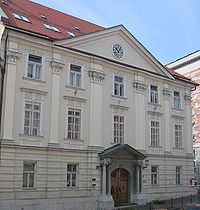Joseph Schemerl from Leythenbach
Joseph Schemerl , from 1811 Knight von Leythenbach (born March 26, 1752 in Laibach , Duchy of Carniola , Habsburg Monarchy ; † January 28, 1844 in Vienna , Austrian Empire ) was an architect, hydraulic engineer and specialist book author.
job
Joseph Schemerl attended the Jesuit grammar school in Ljubljana, where a teacher made him enthusiastic about hydrotechnology. From 1777–1779 he went on a study trip to the Netherlands and German countries to learn about canal construction. Then he worked in Ljubljana, most recently as road construction director. He was occasionally a guest at the round tables at which Sigmund Zois von Edelstein , at that time the richest Krainer, gathered talents from many fields. 1786–1790 he designed the facade of today's Slovenian Academy of Sciences and Arts . Before 1799 he came to Vienna and from 1799–1803 managed the expansion of the Wiener Neustädter Canal .
For the Viennese Danube regulation he proposed a breakthrough in 1810, as it was only realized in 1870–1875 (see here ). In 1811 he was raised to the nobility by Emperor Franz I.

1815–1818 Schemerl directed the planning for the new building of the Polytechnic on Karlsplatz , at that time at the gates of the walled city of Vienna, today the main building of the Technical University of Vienna .
Under Emperor Franz I, Schemerl was appointed councilor in 1804, director of building council in 1809, and councilor in 1833 . He was awarded the Imperial Leopold Order .
In 1836 he was in court and Staatsschematismus the Austrian Kaiserthumes containing the further particulars country estate in Krain , extraordinary council of the Imperial Academy of Fine Arts in Vienna , the Imperial Academy of Fine Arts to honor member Venice and society of agriculture and the arts to Ljubljana mentioned . At that time Schemerl was also head of the court building accounts . Peter Nobile was at his side as court building officer .
family
Schemerl was married to Sara Kappus von Pichelstein (1756–1808) and had seven children with her: Augustin (* 1784), chancellery; Maria Josefa (* 1788); Rosa (* 1789); Raphael (* 1790); Felix Eugen (* 1794); Maria (* 1798) and Josefa (* 1801).
The father of Schemerl's Laibacher interlocutor, Sigmund Zois, Michael Angelo Zois (1694–1777), was married to Johanna Katharina (born 1726) from the same family for the second time.
Death, appreciation

Schemerl died in the so-called Bürgerspitalzinshaus built between 1784 and 1790, which was then the largest rental building in Vienna and was located within the city walls on what is now Albertinaplatz .
The Danube Canal Bridge was named in his honor at the Nussdorf weir and lock system, the Schemerl Bridge, built between 1894 and 1899 and is still called that today.
In 1904 Schemmerlstrasse was named in Vienna's 11th district; how often his name was erroneously spelled Schemmerl instead of Schemerl. The road accompanies the Aspang Railway , built around 1880 , which was built here on the filled in Wiener Neustädter Canal.
Schemerl's year of birth has long been mentioned in the literature as 1754. In the death report in the Wiener Zeitung on January 31, 1844, his age was given as 91, which excludes the year of birth 1754.
literature
- Constantin von Wurzbach : Schemmerl Ritter von Leythenbach, Joseph . In: Biographisches Lexikon des Kaiserthums Oesterreich . 29th part. Imperial and Royal Court and State Printing Office, Vienna 1875, pp. 195–197 ( digitized version ).
- N. Gspan: Schemerl from Leythenbach Josef Maria. In: Austrian Biographical Lexicon 1815–1950 (ÖBL). Volume 10, Verlag der Österreichischen Akademie der Wissenschaften, Vienna 1994, ISBN 3-7001-2186-5 , p. 75 f. (Direct links on p. 75 , p. 76 ).
- Felix Czeike (ed.): Schemerl von Leythenbach, Joseph Maria. In: Historisches Lexikon Wien . Volume 5, Kremayr & Scheriau, Vienna 1997, ISBN 3-218-00547-7 , p. 75 ( digitized version ).
- Franz Vallentin: Schemerl von Leythenbach, Joseph . In: Allgemeine Deutsche Biographie (ADB). Volume 53, Duncker & Humblot, Leipzig 1907, p. 748 f. (The dates of death given in this entry are incorrect.)
Web links
- Joseph Maria Schemerl. In: Architects Lexicon Vienna 1770–1945. Published by the Architekturzentrum Wien . Vienna 2007.
- Joseph Schemerl von Leythenbach in the Vienna History Wiki of the City of Vienna
Individual evidence
| personal data | |
|---|---|
| SURNAME | Schemerl from Leythenbach, Joseph |
| ALTERNATIVE NAMES | Schemerl von Leythenbach, Joseph Maria |
| BRIEF DESCRIPTION | Austrian architect and hydraulic engineer |
| DATE OF BIRTH | March 26, 1752 or March 26, 1754 |
| PLACE OF BIRTH | Laibach , Duchy of Carniola , Habsburg Monarchy |
| DATE OF DEATH | January 28, 1844 |
| Place of death | Vienna , Austrian Empire |
